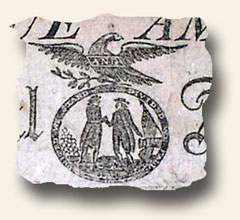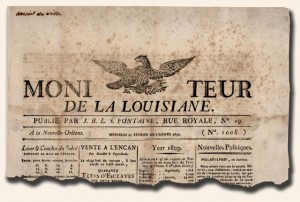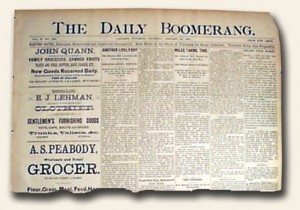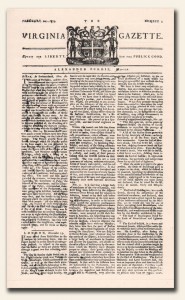They put it in print… First appearance of an American flag?
February 13, 2015 by TimHughes · Leave a Comment
Many in our hobby like to pursuit the very first time “they put it in print” and the “it” can be a very wide range of announcements, reports, or images. Certainly first reports of major 18th  and 19th century battles have been among the favored issues of collectors, and most certainly the first printing of ht Declaration of Independence in a newspaper commands a considerable premium among those who are able to consummate that pursuit.
and 19th century battles have been among the favored issues of collectors, and most certainly the first printing of ht Declaration of Independence in a newspaper commands a considerable premium among those who are able to consummate that pursuit.
Two collectors, Michael Zinman and Steve Lomazow, raised an interesting question: what newspaper was the first to include a print of the U.S. flag within its pages? After discovering several newspapers from 1847 and then 1840 with flag engravings, we found in our database the “True American & Commercial Advertiser” from Philadelphia, 1806 which incorporates a U.S. flag (albeit a small engraving: see photo) within the masthead image (see sample). The newspaper actually began in 1798 but that didn’t mean the masthead engraving was there. Typically mastheads change, often several times, through the life cycle of a newspaper.
But a confirmation from Vincent Golden, newspaper librarian at the American Antiquarian Society, which has holdings of this title going back to issue number 1, confirms the engraving with the flag is, indeed, present with that very first issue.
So this sets the earliest appearance of the U.S. flag in a newspaper at July 1, 1798. But I’m not convinced this is the earliest date. Are any of you collectors aware of an earlier appearance? Check your collections and share with the rest of us!
A gem from the American Antiquarian Society…
January 30, 2015 by TimHughes · Leave a Comment
 In celebration of its 20oth anniversary the American Antiquarian Society published a beautiful exhibition catalog titled “In Pursuit Of A Vision – Two Centuries of Collecting at the American Antiquarian Society”. Featured are a fascinating array of books, documents, maps & other paper ephemera, as well as several very rare & unusual newspapers we felt worthy of sharing with our collectors (with permission from the A.A.S.).
In celebration of its 20oth anniversary the American Antiquarian Society published a beautiful exhibition catalog titled “In Pursuit Of A Vision – Two Centuries of Collecting at the American Antiquarian Society”. Featured are a fascinating array of books, documents, maps & other paper ephemera, as well as several very rare & unusual newspapers we felt worthy of sharing with our collectors (with permission from the A.A.S.).
93. “Moniteur de la Louisiane“, New Orleans, February 21, 1810
The Moniteur de la Louisiane, established in 1794 by Louis Duclot, was the first newspaper published in Louisiana. Because so few early issues have survived, its history is difficult to piece together. The earliest known issue — since lost in a fire but preserved in facsimile — was dated August 25, 1794; all other extant issues are from the 1800s. Although founded when Louisiana was under Spanish control, the Moniteur was published primarily in French, the language of Louisiana’s majority population. Over time the newspaper grew in size from octavo to quarto to folio, and it also change publishers. This 1810 issue lists Jean Baptiste Le Seur Fontaine as publisher, A role he had assumed by 1803 and perhaps as early as 1797. Publication apparently ceased in 1814. When Fontaine died that year, he bequeathed to the city of New Orleans his personal file of the Moniteur.
This is one of two issues of the Moniteur sent to AAS by Edward Larocque Tinker as part of his very substantial gift of early Louisiana newspapers and periodicals.
Wyoming’s first newspapers…
July 9, 2012 by TimHughes · 1 Comment
Wyoming has the interesting distinction of having once been part of four principal annexations: the Louisiana Purchase, the Oregon Territory, the Mexican Cession and Texas Annexation. It became a territory in July, 1868 and gained statehood on July 10, 1890.
The “Leader” was the first newspaper in Wyoming, begun on September 19, 1867, the same year that the first settlement had been created at Cheyenne. The newspaper was begun by Nathan Baker and J.E. Gates. Baker gained his printing experience in Colorado, working at the “Rocky Mountain Herald” and the the “Rocky Mountain News”. He went one to establish two other newspapers in Wyoming, the Laramie “Sentinel” on May 1, 1869, and the South Pass “News“. See the hyperlink for the interesting history of this town.
 Also begun in Cheyenne in 1867 were the “Daily Argus” in October, and the “Star” in December, but neither one lasted beyond two years. Other early newspapers in Wyoming were the “Sweetwater Miner” at Fort Bridge in February, 1868, a vehicle to promote immigration, and a few months later the “News” at South Pass, noted above.
Also begun in Cheyenne in 1867 were the “Daily Argus” in October, and the “Star” in December, but neither one lasted beyond two years. Other early newspapers in Wyoming were the “Sweetwater Miner” at Fort Bridge in February, 1868, a vehicle to promote immigration, and a few months later the “News” at South Pass, noted above.
One of the more interesting newspapers from the West was the “Frontier Index” which began at Fort Sanders and moved along with the Union Pacific railroad going to Benton then to Bryan and then to Bear River City where it was completely destroyed by a mob. And no mention of Wyoming’s newspaper history should fail to mention the “Boomerang” (named for the editor’s mule), founded at Laramie on March 11, 1881 by Bill Nye. Subscribers were found in every state and some foreign countries. When Nye retired from the paper he became one of America’s best known humorists.
Virginia’s first newspapers… and much more.
April 23, 2012 by TimHughes · Leave a Comment
With the focus of today’s post being the first newspapers in Virginia, I discovered that the story as told by the existing “Virginia Gazette”, at www.vagazette.com provides a thorough, interesting and well-written documentation on not just Virginia’s first newspaper but all early printing of news in Virginia. So it is to to them that we give credit for the following:
 If there is nothing as fragile as news, the fragility of newspapers themselves runs a close second. Hundreds of newspapers have begun with great ambition, only to merge with others or fold from bankruptcy.
If there is nothing as fragile as news, the fragility of newspapers themselves runs a close second. Hundreds of newspapers have begun with great ambition, only to merge with others or fold from bankruptcy.
With that knowledge, William Parks might be the most astonished person of all to learn that his “Virginia Gazette” survives intact nearly 270 years after he published the first four-page edition on Aug. 6, 1736.
Newspapers were a long time coming to colonial Virginia. English law precluded any printing by the colonists for years after Jamestown was founded in 1607. The royal governors did not allow any printing until 1690, and even then printers were governed by royal instructions which required a license and the governor’s permission.
One of those governors, Sir William Berkeley, put it bluntly. “I thank God, there are no free schools nor printing, and I hope we shall not have these hundred years; for learning has brought disobedience, and heresy, and sects into the world, and printing has divulged them, and libels against the best government. God keep us from both.”
An enterprising fellow tried anyway.
In 1682, a printer named William Nuthead arrived at Jamestown, then the capital. He set up his press and began to publish the acts of the recently adjourned Assembly. He also printed several other papers about which nothing is known.
Nuthead was called before the governor and the council, where he was ordered to stop the presses “until the signification of his Majesties pleasure shall be known therein.” Within months that “pleasure” was known when a royal order was issued that “no person be permitted to use any press for printing upon any occasion whatsoever.”
With that definitive ruling, Nuthead packed up and returned to his native Maryland. Printing was nonexistent in the colony for nearly 50 years thereafter.
Government policy eventually eased and a more tolerant attitude prevailed. In 1730 William Parks moved from Annapolis to Virginia’s new capital, Williamsburg, to open a branch office. Parks had only three years earlier founded Maryland’s first newspaper, “The Maryland Gazette”.
Parks was an eminent printer. Before arriving in Maryland he operated printing shops in three locations of his native England – Ludlow, Hereford and Reading.
Parks had an effect on Williamsburg. Right from the start his Gazette had the professional touch of a master craftsman. News in the Gazette was taken largely from letters written abroad and recently arrived in the hands of the printer himself or friendly readers. Information was also taken from English papers and other colonial sheets.
There was not much local news in Parks’ Gazette. What little there was appeared primarily in advertisements of recent ship arrivals, shops opening, runaway slaves, deserted spouses, and strayed horses.
By today’s standards The Virginia Gazette of 1736 would look gray and ponderous. There were no headlines, no photographs, no fancy page makeup. But there was news, and for a town that never had a newspaper before it was welcome.
A typical day for William Parks had him working ten hours, perhaps more if he was printing his weekly Gazette on his sheet-fed handpress. It was a laborious process of setting the type by hand, picking letter by letter from a box of matrices.
Once the type was set it was locked into place in a metal form. The type was inked and paper was laid across. The form was rolled into the press, where the pressman “pulled” an impression by yanking with both arms the big handle of the press. This pressure forced the press to screw down on the paper and imprint the type on the paper sheet. Around 200 sheets an hour were printed this way, then hung to let the ink dry.
Hours were dictated largely by daylight, although some type was composed by candlelight. This led to errors and an occasional mishap in which trays of painstakingly set type were “pied” or spilled.
Colonial printers were hampered by a scarcity of type that slowed the printing of books because only a few pages could be set at a time before the letters were reused.
Weather frustrated many a printer, Parks included. Winter cold slowed the mails on which the Gazette was so dependent for news. When no dispatches arrived, Parks would offer that as an excuse for printing a shorter sheet. Spring and fall were the busy time during which the General Court convened in Williamsburg. Summer and winter were comparatively dull, and this is reflected in the Gazettes of the period.
Censorship also posed problems, and from three sectors: the English government, local authorities, and an offended public.
The last major problem faced by colonial printers was a shortage of paper. This was handmade stuff, consisting of ground-up rags. It was tough and durable but varied in quality. In 1743 at the urging of Benjamin Franklin, Parks set about building his own paper mill in Williamsburg. Over the next four years Franklin sold Parks 11,382 pounds of rags. Appeals were often printed asking readers to save their old clothes for paper-making purposes. Old shirts, caps, dresses, handkerchiefs and gowns were brought and subsequently returned to the reader in a different form.
In early 1750 Parks sailed for England on a business trip. During the voyage he was seized with a fatal attack of pleurisy and was buried at journey’s end in Gosport, England.
The stature of William Parks in journalism history can be measured in part by the number of “firsts” to his credit:
- First newspaper in Maryland.
- First public printer in Virginia.
- First newspaper in Virginia.
- First publications of literary works in Virginia.
- First paper mill south of Pennsylvania.
- First postmaster of Virginia.
Following the death of William Parks in 1750, his associate in business, William Hunter, bought the printing shop and with it the Gazette. Hunter went on to distinguish himself in the tradition of William Parks.
He served jointly with Benjamin Franklin as deputy postmaster general for all the colonies. He also printed in 1754 the first published writings of George Washington, “The Journal of Major George Washington,” who at the time was 22 years old.
If there ever was a heyday for newspapers in Virginia and Williamsburg, it was during the Revolution. Albeit partisan, The Virginia Gazette and other colonial newspapers reported well the news of the growing unrest between the Crown and the colonies.
Fully 10 years before the Declaration of Independence, there appeared carefully worded accounts. The repeal of the Stamp Act in March 1766 brought great rejoicing to the colonies and was covered locally in The Virginia Gazette on June 20, 1766.
“On Friday last, a good deal of Company being in Town at the Oyer and Terminer Court, our Gratitude and Thankfulness upon the joyful Occasion of the Repeal of the Stamp Act and the universal Pleasure and Satisfaction it gives that all Differences between the Mother Country and her Colonies are so happily terminated, was manifested here by general illuminations…”
Hunter died in 1761 and was succeeded by another brother-in-law, Joseph Royle. Hunter’s will stipulated that Royle manage the business for himself and Hunter’s infant son, William Hunter Jr.
At the urging of Thomas Jefferson and others, William Rind moved from Annapolis in 1766 to set up a rival Virginia Gazette. Jefferson recalled years later that “…we had but one press, and that having the whole business of the government, and no competitor for public favor, nothing disagreeable to the governor could be got into it. We procured Rind to come from Maryland to publish a free paper.”
Rind was elected public printer by the House of Burgesses, giving him an economic foothold in the form of printing documents and laws. As it turned out, the Assembly three years later spread the wealth to both Gazettes when it ordered them to print a large volume of the Acts of Assembly then in force.
Alexander Purdie succeeded Joseph Royle as publisher of the original Virginia Gazette. In 1767, Purdie took into the business John Dixon, who by marriage was related to Royle’s widow. Purdie, dissatisfied with the partnership, withdrew to set up his own Virginia Gazette. The first issue appeared Feb. 3, 1775.
If the reader is confused, imagine how confused Williamsburg readers were 200 years ago. By early 1775 there were three separate Virginia Gazettes, all operating in town and all under the same name.
There was Dixon’s Gazette (the original), Rind’s Gazette and Purdie’s Gazette (the newest). They all carried pretty much the same news in largely the same format, four to eight pages weekly. The easiest way to tell them apart was by their mottos. The original Gazette was known to be “Containing the freshest Advices, Foreign an Domestick.” Rind’s Gazette promised it was “Open to all Parties but Influenced by None.” Purdie’s declared “Always for Liberty and the Publick Good.”
Nor were these three the only Virginia Gazettes. By 1809 a total of 24 papers in the state had used the term Virginia Gazette in their flags. The reason is simple. “Gazette” in Britain specified “official record” and lent real authority to any periodical with that name. In the colonies, the Assemblies ordered their resolutions and proclamations printed “in the Gazette” or “in The Virginia Gazette” for public attention and consumption.
But it was not specified which Gazette was to get the business, leaving it up for grabs in Williamsburg among three papers. A printer calling his paper, say, The Williamsburg Bugle, was automatically eliminating himself from any government income.
Rind’s paper was taken over upon his death in 1773 by his wife, Clementina. She thus became the first woman printer and editor in Virginia, and is credited by at least one historian as one of the 10 pioneer women journalists in America.
By 1775 John Pinkney took over as manager and then in 1776 as owner of Mrs. Rind’s shop and paper, but he moved to North Carolina early in 1777 and died in August that year. This marked the end of the second Virginia Gazette.
The third Gazette operated by Alexander Purdie continued after his death in 1779. His nephew, John Clarckson, and one of his printers, Augustine Davis, ran it until the end of 1780 when it ceased operations because the capital had moved.
Purdie’s Gazette continued to be a sparkling newspaper after it was formed anew in 1775 and Dixon was left with the original Gazette. Perhaps because Dixon’s new partner, William Hunter Jr., was a loyalist, the original Gazette dragged its feet on covering the Revolution. In any event, Purdie continually scooped the other two Gazettes.
On Feb. 2, 1776, Purdie printed excerpts from Tom Paine’s pamphlet, “Common Sense,” the famous statement of arguments for independence. John Pinkney ran it the next day in his Virginia Gazette.
Reporting the Declaration of Independence
Purdie also beat the competition on breaking the Declaration of Independence. He published a brief reference to it by way of the postmaster in Fredericksburg on July 12, just 10 days after Congress resolved that the united colonies were free and independent states. (It wasn’t declared until July 4.)
The following Friday, July 19, Purdie ran key passages from the Declaration, promising to print the entire document next week. Dixon and Hunter followed suit and the two Gazettes ware thought to be the first papers outside Philadelphia to print the Declaration verbatim.
What’s curious is how the two Gazettes played it up – or down. Purdie ran it as lead story on Page 1, which it consumed entirely before concluding atop page 2. There were also reports on the proclamation of the Declaration in Trenton, New York and Williamsburg.
Dixon and Hunter, on the other hand, ran the Declaration on Page 2, reserving Page 1 for lesser accounts about shipping, naval matters and a death. (Pinkney’s Gazette didn’t run it at all – it had folded the previous February.)
No one knew during these troubled times what the outcome of the Revolution would be. But the Gazettes and the other 34 colonial newspapers reported the excesses of the British government and the steps taken by the colonists to guarantee their own freedoms.
More than the political pamphlet and more than the sermons by political clergy, the colonial newspaper contributed the most to the propaganda of the Revolution. The Patriot press inspired the colonies to rebel against tyranny, and it worked.
First newspapers in South Dakota…
February 13, 2012 by TimHughes · Leave a Comment
The very first printing of any kind to be done in present-day South Dakota wasn’t until Sept. 20, 1858, relatively late for that section of the country. It was an election notice, and less than a year later the first newspaper appeared on July 2, 1859 titled the “Democrat“, printed in Sioux Falls. It published on an irregular schedule for less than a year when it was discontinued for lack of support. Reports are that the newspaper was revived as the “Northwestern Democrat“, however no copies under that name have survived. The press was destroyed by a band of hostile Sioux Indians in 1862.
 The second newspaper in South Dakota was the “Weekly Dakotian” begun in Yankton on June 6, 1861, by Frank Ziebach. A year later it was absorbed by its rival, the “Press“, becoming the “Press and Dakotan“, and a bit later the “Dakota Union“.
The second newspaper in South Dakota was the “Weekly Dakotian” begun in Yankton on June 6, 1861, by Frank Ziebach. A year later it was absorbed by its rival, the “Press“, becoming the “Press and Dakotan“, and a bit later the “Dakota Union“.
Note: Images are not currently available for any of the above… but will be added if/when they are available.
Perhaps the most famous 19th century title is “The Black Hills Pioneer” which was printed in Deadwood City beginning in 1876. It would be an issue in early August of that year that would report the death of Wild Bill Hickok while playing cards that would be one of the most sought after newspapers for any collection.




